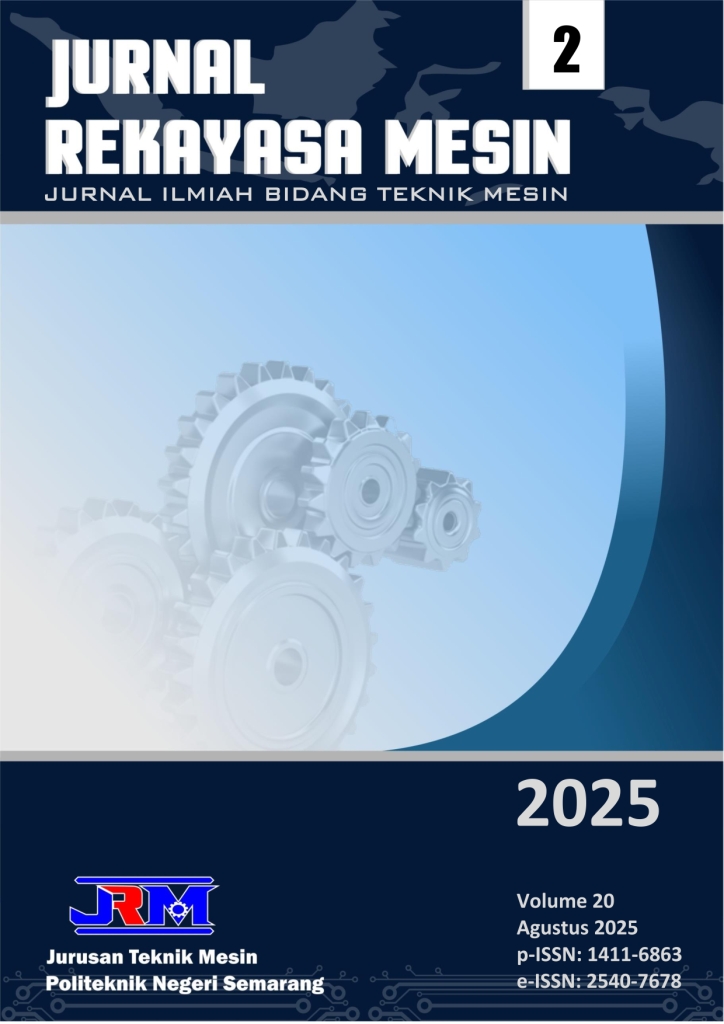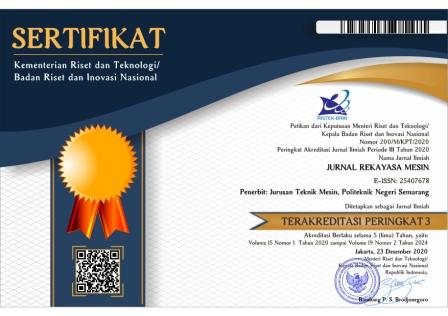The Effect of Injection Parameters on Warpage, Shrinkage, and Tensile Strength of Polypropylene Composites
DOI:
https://doi.org/10.32497/jrm.v20i2.6573Keywords:
holding pressure, composite, tensile strength, mold temperature, shringkage, warpageAbstract
Polypropylene composite material is an environmentally friendly material when compared to other polymer materials because the composition of polypropylene is only 76% and the remaining 24% is limestone. The use of this composite material is to reduce dependence on the use of Acrylonitrile Butadiene Styrene (ABS) and Acrylic Styrene (AS) resins because both materials are difficult to decompose and recycle. The "base" product made from this material has a warpage defect that causes a gap effect when the product is installed with other components. Therefore, a study was conducted on the effect of mold temperature and holding pressure on warpage defects, shrinkage, tensile strength and surface morphology. This study used an experimental method with variations in mold temperature used were 20°C, 40°C, and 60°C, variations in holding pressure used were 70 bar, 110 bar, and 150 bar. Testing was carried out by measuring dimensions to determine warpage, shrinkage percentage, measuring tensile strength and observing surface structure. The warpage value decreases by 29% at high mold temperatures and increases by 84% at high holding pressure. The shrinkage percentage decreases with increasing mold temperature and holding pressure in the transverse direction by 7.14%-9.52% at constant pressure and 25%-26.29% at constant temperature, in the longitudinal direction by 1.27%-6.21% at constant pressure and 13.92%-17.95% at constant temperature. The optimal parameters to obtain the highest tensile strength of 26.77 MPa are at a mold temperature of 60°C and a holding pressure of 110 bar.
References
[1] C. Webb, K. Qi, L. Anguilano, and X. Schmidt Rivera, “Mechanical and environmental evaluation of ground calcium carbonate (CaCO3) filled polypropylene composites as a sustainable alternative to virgin polypropylene,” Results in Materials , vol. 22, June. 2024, doi: 10.1016/j.rinma.2024.100562.
[2] Y. Peng, M. Musah, B. Via, and X. Wang, “Calcium carbonate particles filled homopolymer polypropylene at different loading levels: Mechanical properties characterization and materials failure analysis,” Journal of Composites Science , vol. 5, no. 11, Nov. 2021, doi: 10.3390/jcs5110302.
[3] WC Lin, FY Fan, CF Huang, YK Shen, and H. Wang, “Analysis of the Warpage Phenomenon of Micro-Sized Parts with Precision Injection Molding by Experiment, Numerical Simulation, and Gray Theory,” Polymers (Basel) , vol. 14, no. 9, May 2022, doi: 10.3390/polym14091845.
[4] İ. Karagöz, “An effect of mold surface temperature on final product properties in the injection molding of high-density polyethylene materials,” Polymer Bulletin , vol. 78, no. 5, pp. 2627–2644, May 2021, doi: 10.1007/s00289-020-03231-2.
[5] K. Fahmi Aziz, A. Zainul Muttaqin, I. ardiatama, H. Arbiantara, and D. Djumhariyanto, “THE EFFECT OF HOLDING TIME AND MOLD TEMPERATURE ON WARPAGE DEFECTS IN THE AL-PP COMPOSITE PROCESS WITH INJECTION MOLDING,” 2022.
[6] Agus Kholistiyanto and Sulistyono Sulistyono, “Analysis of the Impact of Variations in Injection Temperature and Cooling Time Parameters on Oval Tube Cap Product Defects in the Injection Molding Process,” Mars: Journal of Mechanical, Industrial, Electrical and Computer Science Engineering , vol. 3, no. 1, pp. 172–183, Jan. 2025, doi: 10.61132/mars.v3i1.672.
[7] P. Mechanical Engineering Study Program, Jambi City National Technology College, M. Mechanical Engineering Study Program, Jambi City National Technology College, L. Trisyathia Quentara, and A. Tranggono Agus Salim, “Multi-Response Optimization of Biocomposite Material Injection Molding Process Parameters Using the Taguchi-PCR TOPSIS Sufiyanto Method,” 2021.
[8] R. Yadav, A. Pancharya, and R. Kant, “Influence of injection and holding pressure on tribological and mechanical behavior of injection molded thermoplastic,” in Materials Today: Proceedings , Elsevier Ltd, 2020, pp. 915–920. doi: 10.1016/j.matpr.2020.09.486.
[9] N. Hadler Marins, F. Bier de Mello, R. Marques Silva, and F. Aulo Ogliari, “Statistical Approach to Analyze the Warpage, Shrinkage and Mechanical Strength of Injection Molded Parts.” [On line]. Available: www.hanser-elibrary.com
[10] M. Moayyedian, MRC Qazani, PJ Amirkhizi, H. Asadi, and M. Hedayati-Dezfooli, “Multiple objectives optimization of injection-molding process for dashboards using soft computing and particle swarm optimization,” Sci Rep , vol. 14, no. 1, p. 23767, Dec. 2024, doi: 10.1038/s41598-024-62618-7.
[11] P. Postawa and J. Koszkul, “Change in injection molded parts shrinkage and weight as a function of processing conditions,” in Journal of Materials Processing Technology , May 2005, pp. 109–115. doi: 10.1016/j.jmatprotec.2005.02.241.
[12] J. Nabiałek, “SIMULATION STUDIES OF THE IMPACT OF THE GATE LOCATION ON THE DEFORMATION OF THE PA6 GF30 INJECTION MOLDED PART,” Archives of Metallurgy and Materials , vol. 69, no. 2, pp. 699–703, 2024, doi: 10.24425/amm.2024.149799.
[13] E. Raahede, K. Stephan, H. Christian, M. Aminul, and H. Nørgaard, “General rights Examining the influence of injection speed and mold temperature on the tensile strength of polypropylene and ABS.”
[14] X. Zhang et al. , “Non-monotonic Information and Shape Evolution of Polymers Enabled by Spatially Programmed Crystallization and Melting,” Chem & Bio Engineering , Oct. 2024, doi: 10.1021/cbe.4c00058.
[15] M. Kumar, “effect-of-injection-molding-process-parameter-on-tensile-strength-using-taguchi-method”, doi: 10.5281/zenodo.1110115.
Downloads
Published
How to Cite
Issue
Section
License
Copyright (c) 2025 Julius Andre Bawono, Budiarto, Perwita Kurniawan

This work is licensed under a Creative Commons Attribution-NonCommercial-ShareAlike 4.0 International License.
Copyright of articles that appear in Jurnal Rekayasa Mesin belongs exclusively to Penerbit Jurusan Teknik Mesin Politeknik Negeri Semarang. This copyright covers the rights to reproduce the article, including reprints, electronic reproductions, or any other reproductions of similar nature.







